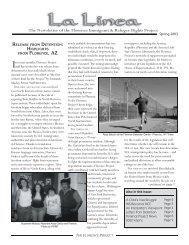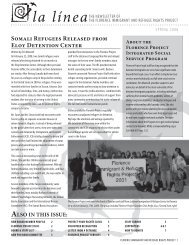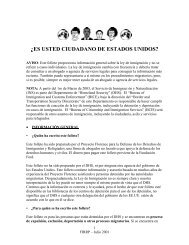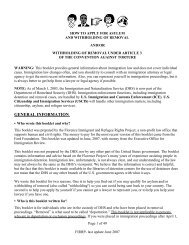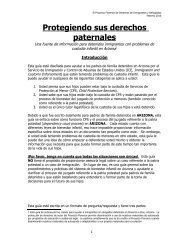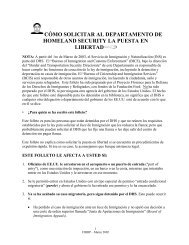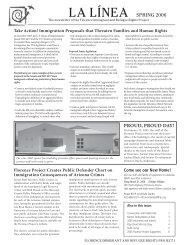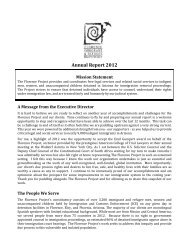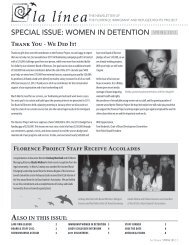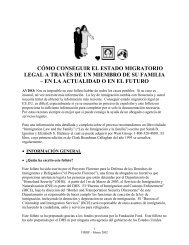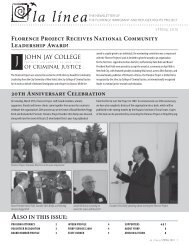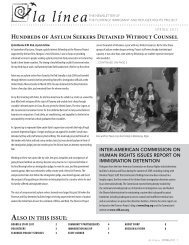quick reference chart and annotations for determining immigration ...
quick reference chart and annotations for determining immigration ...
quick reference chart and annotations for determining immigration ...
Create successful ePaper yourself
Turn your PDF publications into a flip-book with our unique Google optimized e-Paper software.
Immigrant Legal Resource Center, Florence Immigrant <strong>and</strong> Refugee Rights Project,<br />
Maricopa County Public Defender August 2012<br />
Domestic Violence: Where felony burglary is a crime of violence <strong>and</strong> there is a DV type victim,<br />
it is conceivable that it will be held a domestic violence offense triggering deportation. Counsel should<br />
keep the record of conviction from identifying the domestic relationship. Immigration counsel will argue<br />
that only crimes against persons, not property, qualify as deportable domestic violence offenses.<br />
Burglary in the First Degree, ARS §13-1508<br />
A. A person commits burglary in the first degree if such person or an accomplice violates the provisions<br />
of either section 13-1506 or 13-1507 <strong>and</strong> knowingly possesses explosives, a deadly weapon or a<br />
dangerous instrument in the course of committing any theft or any felony.<br />
B. Burglary of a nonresidential structure or a fenced commercial or residential yard is a class 3 felony. It<br />
is a class 2 felony if committed in a residential structure.<br />
Crime Involving Moral Turpitude: With the correct record of conviction, this might escape<br />
classification as a CMT since all of the component offenses may be non-CMTs. Entry with intent to<br />
commit an undesignated offense (“a felony”) or an offense that does not involve moral turpitude is not a<br />
CMT. Matter of M, 2 I&N Dec. 721 (BIA 1946). However, a class 2 <strong>for</strong> residential structure will likely<br />
be found a CMT regardless of the underlying crime. Matter of Louissaint, 24 I&N Dec. 754 (BIA 2009)<br />
(burglary of an occupied dwelling is categorically a CMT). The additional element of a weapon might not<br />
trans<strong>for</strong>m the conviction into a CMT. See, e.g., Matter of Montenegro, 20 I&N Dec. 603 (1992) (“The<br />
moral condemnation comes from the act of burglary or rape, not the fact that the criminal had a gun in his<br />
pocket”). The fact that possession of a weapon is an element of the offense may lead some <strong>immigration</strong><br />
judges to analogize it to residential burglary in that is more likely to invite a violent defensive response<br />
from the resident. Matter of Louissaint, 24 I&N Dec. 754, 758 (BIA 2009).<br />
Aggravated Felony: See § 13-1506. However, the only truly safe strategy is to avoid a sentence<br />
of a year or more. There is no case on point. Although simple possession of a weapon is not a crime of<br />
violence, Matter of Rain<strong>for</strong>d, 20 I&N Dec. 598 (BIA 1992), it is possible that a court would hold that the<br />
presence of a weapon will trans<strong>for</strong>m an offense that is not a crime of violence into a crime of violence.<br />
Firearms Deportation Ground: A noncitizen is deportable if he is convicted of possessing a<br />
firearm or destructive device in violation of the law. 8 USC § 1227(a)(2)(C). A destructive device<br />
includes explosives. To avoid this ground, counsel should keep the record of conviction vague as to the<br />
weapon of possession <strong>and</strong> plead defendant to the statutory language in the disjunctive “explosives, a<br />
deadly weapon or a dangerous instrument,” or “deadly weapon,” or “dangerous instrument.” Examples of<br />
non-firearm dangerous weapons are: knives, sticks, clubs, rods, etc.<br />
Domestic Violence: Where felony burglary is a crime of violence <strong>and</strong> there is a DV type victim,<br />
it is conceivable that it will be held a domestic violence offense triggering deportation. Counsel should<br />
avoid a <strong>reference</strong> to § 13-3601 <strong>and</strong> keep the record of conviction from identifying the domestic<br />
relationship. Immigration counsel will argue that only crimes against persons, not property, qualify as<br />
deportable domestic violence offenses.<br />
33. Criminal Damage, ARS § 13-1602<br />
A. A person commits criminal damage by recklessly:<br />
1. Defacing or damaging property of another person; or<br />
2. Tampering with property of another person so as substantially to impair its function or value; or<br />
3. Tampering with the property of a utility.<br />
Arizona Criminal Chart with Explanatory Endnote – August 2012<br />
49



